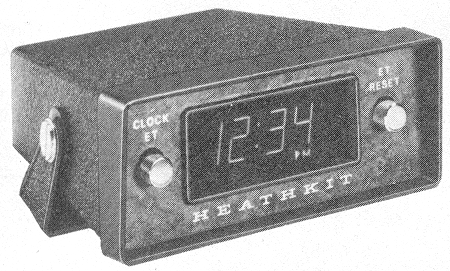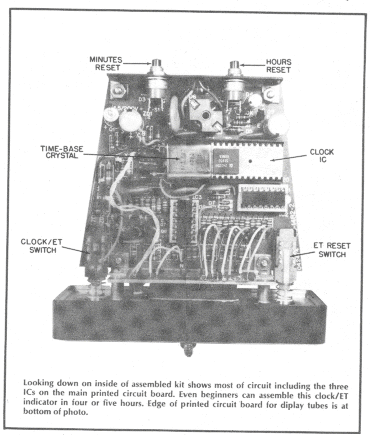 Whether you're a rallye driver who neeeds to clock the ET (elapsed
time per event), a traveller looking to the end of a trip, or just
someone who wants a conversation piece in the car, the Hetahkit GC-1093
Digital Car Clock is the way to go.
Whether you're a rallye driver who neeeds to clock the ET (elapsed
time per event), a traveller looking to the end of a trip, or just
someone who wants a conversation piece in the car, the Hetahkit GC-1093
Digital Car Clock is the way to go.
Just as the name implies, the GC-1093 has a digital readout, using what is by now Heathkit's "standard" oversize (about 1/2-inch) gas-discharge display.
The dual purpose clock is housed in a small cabinet 4-5/8-inches wide x 1-7/8-inches high and 4-3/4-inches deep. A mobile mounting bracket similar to the type used for CB transceivers is provided for underdash mounting. If you'd like the clock out for all to see it can be placed on top of the dash. The power source is 10 to 17 VDC with a negative ground.
In addition to the required numerals the digital display also indicates the colon as in 12:56, and a.m. or p.m. The a.m. and p.m. indicators are also used to show the clock and ET modes. When the a.m. or p.m. indicator is on, the time is displayed. If the a.m. and/or p.m. indicator is not shown, elapsed time is being indicated. In the clock mode, time is indicated in hours and minutes. In the ET mode, the clock counts in minutes and seconds to 9:59, at which point it automatically switches to hours and minutes to a maximum 19 hours and 59 minutes.
 Back and Forth.
Both the clock and ET counters run continuously regardless of the display
selected. For example, if the ET is running and you switch to the
"clock" mode for the correct time, and you switch back to ET display,
it picks up the correct elapsed time. Similarly, if you switch the
display from ET to clock, the correct time is displayed.
Back and Forth.
Both the clock and ET counters run continuously regardless of the display
selected. For example, if the ET is running and you switch to the
"clock" mode for the correct time, and you switch back to ET display,
it picks up the correct elapsed time. Similarly, if you switch the
display from ET to clock, the correct time is displayed.
Maximum power from the battery - about 300 mA - is consumed when the display is on; but only 30 mA - an insignificant value - is required to run the counting circuits, so the clock has three power wires. One wire is ground, the second wire connects directly to the car battery providing full-time power for the counters, while the third wire connects to the battery through the ignition switch. When the ignition is off, the display is off, but the counters keep running, so the correct time is indicated when the display is turned on by the ignition switch. Provision is made, as we'll show, to turn on the display even when the ignition switch is off.
The front panel has two pushbutton switches: labeled CLOCK ET and ET RESET. When the CLOCK ET switch is out, the correct time is displayed. When the switch is in, the elapsed time is displayed. The ET RESET is a momentary-contact switch that resets the ET timer to zero when depressed. It also serves to turn the display on when the ignition switch is off. For example, if you are sitting in the car and want to know the correct time, you simply press the ET RESET. The display goes on and stays on as long as the switch is depressed.
Auto Lumen. To avoid excessive brilliance from the display at night, a photocell sensor built into the display window reduces the display brilliance as the sunlight fades; the display brightness level is lowered to more-or-less match the brightness level of the dashboard lamps.
Two pushbutton switches on the rear of the cabinet are used to set the correct time. One switch advances the hours count each second; the other advances the minute count each second.
If you are at all familiar with standard car clocks, you know they are notoriously inaccurate - that's why few cars come with clocks anymore. But this is not true of the Heathkit GC-1093 which is spec'd for an accuracy of one minute per month at 25°C. The reason for the Hetahkit's accuracy is a crystal controlled time-base oscillator whose output is independent of the battery voltage.
All time-keeping functions including the oscillator are provided by a single integrated circuit (IC). Since power is applied full-time to the counters (only the display is turned off) the clock runs at all times and is instantly ready to indicate the correct time when the display is turned on.
The high voltage for the display device is derived from a one transistor DC-to-DC converter similar to the type used for electronic flash units (strobe lights) and emergency vehicle flashers. Since the approximately 270 mA required to operate the converter could conceivably run down a battery that stood idle for several dsys (more likely a week or two), the power source for the converter - hence the display - is turned off by the ignition switch.
Most of the assembly is on two printed circuit boards; one for the display tube, the other for just about everything else. Heathkit has made assembly really easy for the beginner by providing the display tube pre-mounted on the PC board, and by using sockets rather than individual pins for the ICs. It's rather difficult to make a mistake.
The GC-1093 Digital Car Clock kit is priced at $62.95 plus shipping.